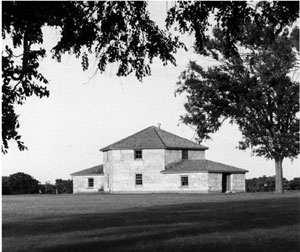Fort Hays
Client: Kansas State Historical Society
Site: Hays, Kansas

Our firm, along with Brent Bowman and Associates of Manhattan, Kansas, were selected by the Kansas State Historical Society to perform a Historic Structures Report and Preservation Plan for this site’s exquisite buildings; the limestone Blockhouse and Guardhouse, and the Officer’s Quarters Numbers Two and Three, wood framed T-plan vernacular style cottages with elements of Greek Revival style, portions of which, are reconstructions of missing sections. Etched in stone are the names of many of the soldiers who were stationed at Fort Hays during its peak period of activity, from the mid–to–late 19th century. The stones upon which, these names are etched form one of the most visually intriguing buildings of any frontier fort, the Fort Hays Blockhouse. The octagonal–shaped, central two-story tower was fitted together during construction of cut native limestone. Unfortunately, over time, erosion had affected the lower course of stones, settlement had occurred in the foundation, and internally structural forces from a roof that had been inadequately braced in the original design, all combined together and resulted in walls that were dangerously out of plumb. Furthermore, well-intentioned but poorly conceived stabilization techniques applied during various periods of the 20th century had only hastened this deterioration. It was only after careful study of all of the forces at work on these buildings, and a team of archaeologists recovered subsurface evidence of early construction, which had been obscured by later concrete floors, did we develop a comprehensive stabilization plan for each one of the buildings. Our plan included surface and subsurface drainage control to remove the negative affects of moisture. Basal erosion on the Blockhouse had progressed to the point where the first two courses of stone had to be stabilized or replaced by stones carefully selected from the original quarry. After we completed a series of mortar analysis on the Blockhouse and Guardhouse, walls were straightened and the masonry repointed with an original mixture as determined by laboratory analysis. New floors were laid in the historic wings of the buildings to match evidence uncovered by archaeological research, and historic roofing was reconstructed, based upon field evaluations of nailing patterns and historic photographs. Windows were stabilized and repaired, and historic plaster was replicated and patched. Finally, museum exhibits were reinstalled, the interiors reopened, and the public can now experience the same original interior views as the soldiers whose names appeared over time in etchings on the Blockhouse’s limestone exterior. This Historic Structures Report was one element in the Kansas Historic Sites Master Plan.
